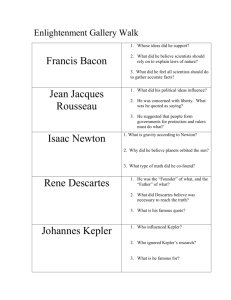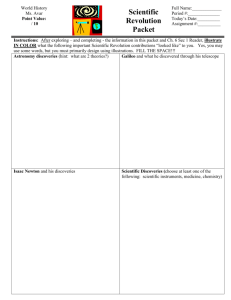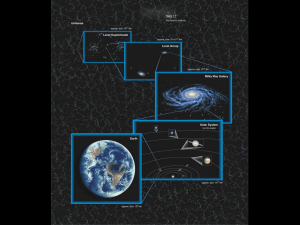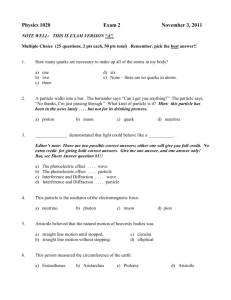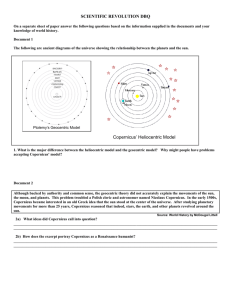Chapter 2 - Langara iWeb
advertisement
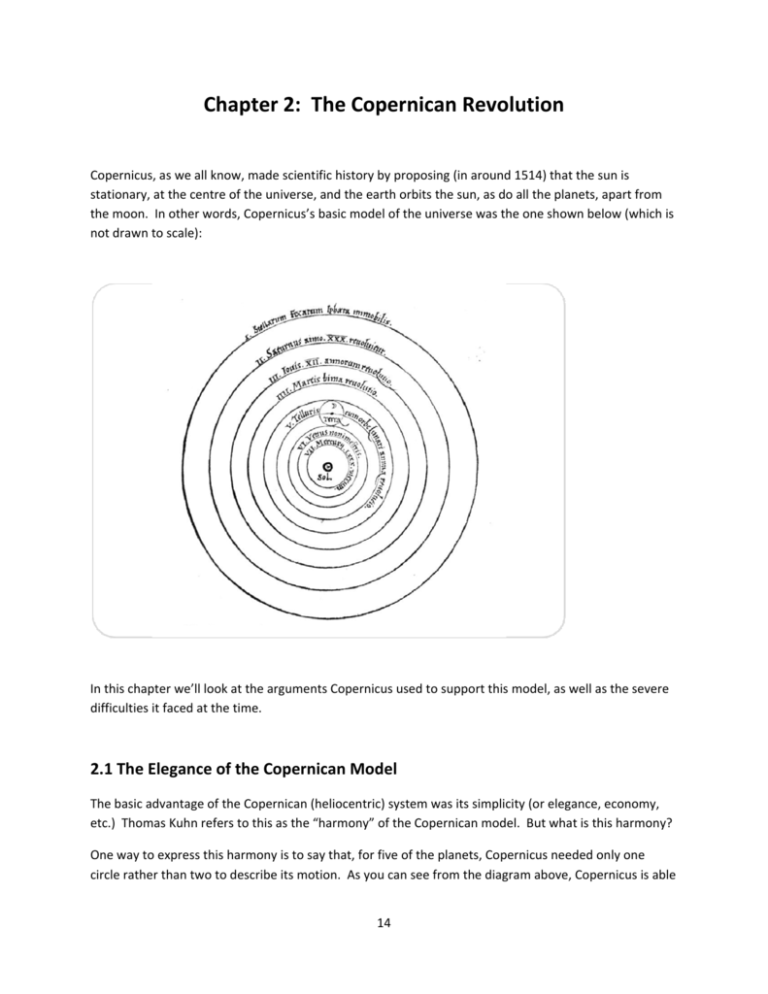
Chapter 2: The Copernican Revolution Copernicus, as we all know, made scientific history by proposing (in around 1514) that the sun is stationary, at the centre of the universe, and the earth orbits the sun, as do all the planets, apart from the moon. In other words, Copernicus’s basic model of the universe was the one shown below (which is not drawn to scale): In this chapter we’ll look at the arguments Copernicus used to support this model, as well as the severe difficulties it faced at the time. 2.1 The Elegance of the Copernican Model The basic advantage of the Copernican (heliocentric) system was its simplicity (or elegance, economy, etc.) Thomas Kuhn refers to this as the “harmony” of the Copernican model. But what is this harmony? One way to express this harmony is to say that, for five of the planets, Copernicus needed only one circle rather than two to describe its motion. As you can see from the diagram above, Copernicus is able 14 to dispense with the epicycles for Mercury, Venus, Mars, Jupiter and Saturn. How then does Copernicus explain the retrograde motions of these planets? From a Copernican perspective, the retrograde motions of the planets are an illusion, caused by the earth’s own motion. Suppose you’re driving down the highway, and overtaking a slower vehicle. In that case the slower vehicle, viewed through your side window, appears to be going backwards, but of course it isn’t really. In a similar way, the apparent retrograde motions of Mars, Jupiter and Saturn occur when the faster earth overtakes them on the inside lane. It is important to realize that, by dispensing with these epicycles, Copernicus also avoided the ad hoc adjustment of the epicycles referred to in Section 1.3.4. In Ptolemy’s model the solar orbit effectively appears in 6 different places in the universe, as three epicycles and two deferents are precisely synchronized to the solar orbit in both orbital period and phase. There are no such curious coincidences in the Copernican model. Consider, in particular, the observed fact that Mercury and Venus never stray far from the sun, as viewed from earth. This fact does not follow from the general epicycle + deferent scheme, since it is easy to construct epicycle models where Venus and Mercury are sometimes in opposition to the sun. In order to explain this fact, Ptolemy had to make the “ad hoc” assumption that the centre of Venus’s epicycle always lies on the straight line between the earth and the sun. In a heliocentric model, however, any planet whose orbit lies inside the earth’s orbit must have limited elongation – just as a matter of basic geometry. No ad hoc fiddling is needed to make the theory fit the data. Let’s pause for a moment here and ask how significant this advantage is, for the Copernican model. According to Thomas Kuhn, the advantage is “largely an illusion”, although it is “a propaganda victory that the proponents of the new astronomy rarely failed to emphasize” (p. 169). Why does Kuhn say such a thing? The reason is that the full Copernican system was just as complex and cumbersome as the Ptolemaic system. For, while Copernicus dispensed with the “major” (large) epicycles that Ptolemy used to explain retrograde motions, he required many “minor” (much smaller) epicycles to achieve a good fit between theory and data. The diagram below shows the Copernican model of the earth’s orbit, and gives some idea of its complexity. The earth (E) does not simply orbit the sun (S). Rather, E orbits the point OE, which orbits O, which orbits S. Thus three circles are needed. (The diagram is not drawn to scale. In Copernicus’s model the two minor epicycles were very small in comparison to the earth‐sun distance, so that the overall orbit of the earth was very nearly circular.) 15 The Earth’s Orbit, for Copernicus (not to scale) In the end, according to Kuhn, both Copernicus and Ptolemy used over 30 circles altogether, and “there was little to choose between them in economy” (Kuhn, p. 169). At the same time, Kuhn acknowledges that the Copernican system has “aesthetic advantages” over the Ptolemaic system, since there are no unexplained coincidences between the solar orbit and other motions elsewhere. In other words, Copernicus had an elegant explanation for the sun’s special role in the universe. Is this advantage flimsy, and mere propaganda, as Kuhn claims? Or does it have the rational force that Copernicus himself argues? Let us summarise the strengths and weaknesses of the Copernican system discussed so far. The strength is that Copernicus has a neat explanation for why the motions of all the planets (apart from the moon) appear to be tied to the sun’s motion. The two weaknesses are that (i) the system is no more accurate in its predictions than Ptolemy’s, and (ii) overall it is just as complicated as Ptolemy’s model. 2.2 Measuring the Orbital Radii Another advantage of the Copernican model over the Ptolemaic was that Copernicus could calculate the precise mean radius of each planet’s orbit, at least as a multiple of the earth‐sun distance. Recall that Ptolemy really had no idea how far away any of the planets were. Even the order of the planets was only guessed at, based on the time they each took to orbit the celestial sphere. The basic reason for this was that each planet has both an epicycle and a deferent, which allows a lot of flexibility in constructing a model that fits the data. Consider, for example, the observed fact that Mars’s epicycles appear bigger than Jupiter’s, viewed from earth, in the sense that Mars appears to backtrack further than Jupiter each time it undergoes retrograde motion. In Ptolemy’s model there are two ways one can account for this fact: either by making the two epicycles the same size but putting Jupiter further away (so that its epicycle just looks 16 small) or by making Jupiter’s epicycle actually smaller than Mars’s. In fact, Jupiter can be lower (closer) than Mars in such a system, as long as it moves slowly around its deferent and has a very small epicycle. There is no such flexibility in the Copernican system, where each planet just has one circle in its orbit (ignoring the fiddly minor epicycles). The retrograde motions of Mars, Jupiter and Saturn, if you recall, are an effect (in the Copernican system) of the earth’s orbit around the sun. Since Jupiter’s retrograde motion is smaller than Mars’s, Jupiter must be further away. In fact by measuring the apparent sizes of Mars’s, Jupiter’s and Saturn’s retrograde motions, Copernicus could calculate fairly precisely the radius of each orbit, in proportion to the earth‐sun distance. (N.B. the average earth‐sun distance is called one astronomic unit, or A.U., and is about 150 million km.) Mars’s orbit was found to have a radius of 1.5 A.U., Jupiter’s was 5.2 A.U., and Saturn’s was 9.5 A.U. These were hard numbers, determined directly by astronomical measurements, as well as by the model itself of course. 2.3 Objections to the Earth’s Motion The main objections raised against the Copernican system, in the early 17th century, concerned the claim that the earth moves. There were three main scientific reasons, in those days, why the earth could not move: (i) The earth is heavy, and made of earth, so that it naturally gravitates downwards. It does not naturally move in a circle, so a huge force would be necessary to make it move that unnatural way. What force would be sufficient? (ii) If some enormous force were really propelling the earth around the sun, at over 100,000 km/h, then anything not nailed down would fly off sideways. (iii) If the earth were really travelling around the celestial sphere then we would observe an annual stellar parallax. E.g. when the earth is close to Virgo, it should appear larger, and six months later it should appear smaller. The first two objections are mechanical arguments, and will be discussed in the next chapter (on mechanics). The third objection is kinematic and will be discussed in a moment. In addition to these scientific arguments, there were also Biblical arguments, based on certain verses of the Bible that (interpreted literally) state that the earth is stationary, and that then sun moves. What was Copernicus’s response to this third argument, from the absence of the annual stellar parallax? You can probably guess. That there are no such phenomena for the fixed stars proves their immeasurable distance, because of which the outer sphere’s [apparent] annual motion or its [parallactic] image is invisible to the eyes. For every visible object has a certain distance beyond which it can no more be seen, as is proved in optics. 17 In other words, there actually is an annual stellar parallax – it’s just that it’s too tiny to see, because the outer sphere (containing the fixed stars) is so far away from us. The earth’s orbit is a pretty big circle, of course, but compared to the outer sphere of the heavens it’s just a speck, of no size at all. In short, the universe is hundreds of times bigger than Ptolemy thought. (And he thought it was pretty big!) Copernicus’s solution seems pretty straightforward and unproblematic to us, since the vast size of the universe is something we’ve gotten used to. But in the early 17th century, the enormous gap proposed by Copernicus between the sphere of Saturn (the highest planet) and the outer sphere was pointless, bizarre, and ludicrous. Recall that Saturn’s sphere has a radius of 9.4 A.U., whereas the outer sphere would have to be around 700 times that size, something like 7,000 A.U. If one were to draw the Copernican universe to scale, on a sheet of paper, all the planetary spheres would be invisible, compressed to an infinitesimal dot in the centre. This vast emptiness of the Copernican universe was referred to as the “Copernican abyss”, and was considered dizzying, and wearisome to the mind. Moreover, it had the effect of making the earth seem puny by comparison, and hence unimportant. Moreover, the great astronomer Tycho Brahe argued that the Copernican universe was grotesquely out of proportion, rather like a human body in which “… a finger or a nose should surpass in size the many parts of the entire rest of the body”. Copernicus (and other heliocentrists such as Kepler) had to argue that such an “abyss” of empty space was no big deal. Copernicus argued, for example: The twinkling of the stars, also, shows that there is still a vast distance between the farthest of the planets, Saturn, and the Sphere of the Fixed Stars [for if the stars were very near Saturn, they should shine as he does], and it is chiefly by this indication that they are distinguished from the planets. Further, there must necessarily be a great difference between moving and non-moving bodies. So great is this divine work of the Great and Noble Creator! The stars twinkle, and the planets don’t, which shows that they have a vast space between them. Also, the stationary objects (stars) must be properly separated from the moving parts of the universe (the planets). Are these good arguments? Kepler pointed out that the value and significance of an entity was not at all a matter of its size. We human beings are, after all, just “tiny specks of dust” in terms of size, yet we are also made in the image of God. We are rational souls, and who would want to give up his soul in exchange for mere size? 2.4 Giant Stars The vast size of the stellar sphere in Copernicus’s universe created another problem. Since a bright star had a measured apparent diameter of about 1/15 of the sun’s diameter (i.e. about 1/30 of a degree, or 2 arc minutes) they ought to be about 15 A.U. away, if they are the same size as the sun. Copernicus, as we have seen, placed the stars much further away than that, at a minimum of about 7,000 A.U., which 18 entails a size of around 440 times the sun’s diameter (at least). In fact, even a smaller (third magnitude star) would have a minimum diameter roughly equal to that of the earth’s orbit! Diagram reproduced from Danielson and Graney, Scientific American, January 2014 Copernicus replied to this problem by saying that God, since he is an infinite being, can create stars of any size he wants. In fact, the more important an emperor is, the larger and more majestic his palace should be. So the universe, the palace of God, ought to be of unimaginable size, and contain vast stars! Tycho replied that this argument misses the point, which is that the Copernican universe is internally out of proportion. Of course the universe can be any size God wants it to be, but nature ought to have proportion and balance within itself. The Copernican universe, with its ridiculous disproportions, is therefore absurd. 19 2.5 Enter Galileo and his telescope Faced with these serious objections, the Copernican hypothesis rather languished between 1543 (when Copernicus published his great work, De Revolutionibus Orbium Coelestium) and the early 17th century. Many astronomers used Copernicus’s system, but under the assumption that the earth’s motion was a mathematical fiction rather than physically real. No books supporting the Copernican view were published during this time, although a few astronomers quietly held a heliocentric view. Big things started to happen in astronomy, however, around 1609/1610. In 1609 Johannes Kepler, a renowned mathematician and astronomer, published Astronomia Nova (New Astronomy) – a work that argued strongly for heliocentrism, while also solving many of its mathematical difficulties. In the same year Galileo (1564 – 1642) heard about the recent invention of the telescope and made his own, improved version (with greater magnification). Galileo pointed his first telescope at the heavens, and obtained new data that would cause great difficulties for Ptolemy’s model of the universe. Galileo’s early observations with his telescope were published in 1610, in a short book titled Starry Messenger. Galileo was also a Copernican, having accepted the heliocentric view as a fairly young man, certainly by the age of 33 (i.e. in 1597) when he wrote to Kepler: ....Like you, I accepted the Copernican position several years ago and discovered from thence the causes of many natural effects which are doubtless inexplicable by the current theories. I have written up many of my reasons and refutations on the subject, but I have not dared until now to bring them into the open, being warned by the fortunes of Copernicus himself, our master, who procured immortal fame among a few but stepped down among the great crowd (for the foolish are numerous), only to be derided and dishonoured. I would dare publish my thoughts if there were many like you; but, since there are not, I shall forebear.... You’ll see that Galileo was reluctant at this time to publish his work in support of Copernicus, fearing that he (like Copernicus) might be “derided and dishonoured”. It is no different today, as scientists who propose ideas that lie far outside the mainstream “orthodoxy” generally pay the price of a reduced reputation and career prospects. In his reply Kepler said, “Be of good cheer, Galileo, and come out publicly.” Kepler got his wish. In Galileo’s The Starry Messenger (1610) which described his early observations using a telescope, he included (right at the end) a brief argument for the Copernican view. After this tentative beginning, Galileo gradually became the most aggressive champion of the Copernican heliocentric model, which he was absolutely determined to prove. He argued for it theologically, showing that it was not really in conflict with Holy Scripture. Most famously, in 1632 he wrote a lengthy treatise supporting the Copernican view, titled Dialogues Concerning the Two Chief World Systems. (That book got him into trouble, but more about that later.) First we should discuss what Galileo saw with his telescope, and why it contradicted the universe of Aristotle and Ptolemy. There were 3 such observations: 1. Change and imperfection in the heavens (sunspots and lunar mountains), 2. New ‘planets’ orbiting Jupiter, and 20 3. Venus showing all the phases, like the moon. Galileo also saw other interesting things, such as many stars that were too faint to see with the naked eye, and even the planet Neptune (that was not officially discovered until 1846!). Let us discuss these in turn, and examine their impact on the Aristotelian/Ptolemaic view. Sunspots are observed as small dark patches on the surface of the sun. New ones appear from time to time, and they appear to slide across the sun’s surface, as the sun rotates on its own axis (roughly once per 24 days). After a period of time (anything from a few hours to several months) they disappear again. A Drawing of the sun by Galileo, showing sunspots Sunspots were seen and recognized by Chinese astronomers, as early as 346 BC. In the west they were also seen, but interpreted as the silhouettes of planets (Mercury or Venus) moving in front of the sun, or even as objects in our own atmosphere. A large part of the reason for this was surely Aristotle’s teaching that the realm of the heavens is perfect and unchanging. The sun should be a perfect sphere of aether, and so can have no blemishes on its surface – especially ones that change over time. Galileo was the first astronomer in the west to identify sunspots for what they are, namely areas of darker colour on the sun’s surface. While this didn’t directly threaten Ptolemy’s model of the universe, it did destroy a key idea of the Aristotelian cosmology that was associated with it (in peoples’ minds). Galileo also saw dark areas on the moon’s surface that he (correctly) interpreted as shadows, due to mountains on the moon. More specifically, as the moon waxes and wanes (the illuminated part grows and shrinks), the boundary between the lit and dark portions of the lunar surface is not a clean arc, but rough and jagged. (See Galileo’s sketches below.) Galileo inferred that the lunar surface is not perfectly smooth, as Aristotle taught, but rather very bumpy, with mountains, valleys and craters. Using his understanding of how shadows are formed by 3D objects, Galileo even estimated the heights of lunar mountains! This again did not attack Ptolemy’s model directly, but it did refute some associated ideas of Aristotle. 21 Some of Galileo’s sketches of the moon Galileo’s Starry Messenger also included his observations of ‘new planets’ that apparently orbited Jupiter. In a shrewd political move, Galileo named these the Medicean Stars, after the Grand Duke of Tuscany, Cosimo II de’ Medici and his three brothers. (It doesn’t hurt to make friends in high places.) In the Starry Messenger Galileo didn’t mention the Copernican view until the final page, when he apparently could not resist drawing parallels between Jupiter and the earth, in having their own orbiting planets: Here we have a fine and elegant argument for quieting the doubts of those who, while accepting with tranquil mind the revolutions of the planets about the sun in the Copernican system, are mightily disturbed to have the moon alone revolve about the earth and accompany it in an annual rotation about the sun. Some have believed that this structure of the universe should be rejected as impossible. But now we have not just one planet [the moon] rotating about another [the earth] while both run through a great orbit around the sun; our own eyes show us four stars which wander around Jupiter as does the moon around the earth, while all together trace out a grand revolution about the sun in the space of twelve years. We see from this passage that the discovery of Jupiter’s moons (as they’re now called) did not refute the Ptolemaic system by any means. After all, one can easily add a few extra planets, orbiting Jupiter. But doing so would destroy the general rule that everything orbits the earth. With that tiny change made, it becomes fairly irresistible to modify the orbits of Mercury and Venus so that they actually orbit the sun, rather than orbiting points that are always between the earth and sun. In other words, this observation encourages us to move away from the Ptolemaic model and towards something like the Copernican one. After publishing Starry Messenger in 1610, Galileo continued his work by observing Venus, and here finally he dealt the death blow to the Ptolemaic model. Recall that, for Ptolemy, Venus orbited (in its epicycle) a point that always lies below the sun, on the earth‐sun line (see diagram below, left). According to this model, Venus is always between the sun and the earth, so that it will always appear as a crescent (like a crescent moon, but smaller) or as new (totally dark). For Copernicus, by contrast, Venus orbits the sun, so that it is sometimes on the far side of the sun, as well as coming around to our 22 side. Consequently, Copernicus’s model predicts that Venus will show the full range of phases, just like the moon – full, gibbous, half, crescent and new. (See diagram, below right.) In refuting Ptolemy’s model, Galileo did not prove the motion of the earth, however, for there were other alternative theories available. For example, Martianus Capella argued way back in the 5th century that Venus and Mercury orbit the sun (which in turn orbits the stationary earth) while all the other planets orbit the earth. And the great astronomer Tycho Brahe (1546 – 1601) proposed a model in which Mars, Jupiter and Saturn orbit the sun as well (which still orbits the stationary earth). The Phases of Venus according to Ptolemy (left) and Copernicus (right) 2.6 Johannes Kepler Kepler (1571 – 1630) became a Copernican as a young man, and at the age of 25 (in 1596) published Mysterium Cosmographicum, the first Copernican book of astronomy since Copernicus’s own De Revolutionibus (1543). Kepler’s most famous work of astronomy was the one mentioned above, the New Astronomy (1609). This is the book in which he laid out his theory that all the planets (including earth) move along ellipses rather than circles, around the sun which sits at one ‘focal point’ of the ellipse. This claim is known as Kepler’s first law of planetary motion. Kepler also proposed a second law, concerning the variations in speed of a planet as it moves around its orbit – it gets faster as it approaches the sun, and slower again as it recedes from the sun. The ellipse was a well‐known mathematical curve, having been studied in detail by the great mathematician Apollonius of Perga (262 – 190 BC). It is a very simple curve, almost as simple as the circle, having the property that the sum of the distances a and b (see diagram below) is always constant, and equal to the major axis of the ellipse. Using this property, one can easily draw an ellipse by driving 23 two nails into a board, and putting a loop of string around them. A pencil can then be put inside the loop, and pulled taut to form a triangle. If one then moves the pencil around the nails, keeping the string taut at all times, the resulting closed curve is an ellipse. The nail holes are special points, analogous to the centre of a circle, and are called the focal points. (We might, very loosely, say that the ellipse has two centres.) The ellipse and its two focal points Recall that in Ptolemy’s universe the planetary orbits were not quite centred at the earth, but at an empty point in space, close to the earth. (Such an orbit is called eccentric.) Ptolemy’s placement of this centre was ad hoc. In other words, it was arbitrary from a theoretical perspective, and chosen in order to provide the most accurate predictions. Kepler’s placement of the sun in his universe was not ad hoc in the same way, since he placed the sun at a focus (focal point) of each planet’s elliptical orbit, which is mathematically special, and theoretically definable. And this extraordinary elegance did not come at the expense of empirically accuracy. On the contrary, Kepler’s model soon proved to be far more accurate than that of either Ptolemy or Copernicus. A similar improvement in both elegance and accuracy came from Kepler’s second law, shown below. To account for the varying speed of a planet around its orbit, Ptolemy had introduced a third point (in addition to the earth, and the centre of the planet’s orbit) called the ‘equant’, stating that the angular speed of the planet is constant about its equant. Like the orbit centre, the equant was placed ad hoc, without any theoretical motivation. Copernicus hated the equant for this reason, but had to introduce similarly messy and ad hoc minor epicycles to achieve the same effect. Kepler needed no equant, or similar ad hoc device, but stated simply that the planet sweeps out equal areas in equal times. 24 Kepler’s 2nd (‘equal areas’) law Kepler’s third law appeared in a later work, and precisely related the period of a planet’s orbit to its distance from the sun. Kepler’s laws were later (1687) derived by Isaac Newton from his laws of motion and gravitation. 2.7 Galileo and Kepler It was mentioned above that Galileo and Kepler were on friendly terms, and that Kepler was perhaps the first astronomer to whom Galileo confessed to being a Copernican. Another fun story is that, while Galileo was making his first discoveries with the telescope, he communicated his observations to Kepler (and others) in the form of anagrams. For example, after seeing the phases of Venus, he wrote “Haec immatura a me jam frustra leguntur oy” which means something irrelevant in Latin, but is an anagram of “Cynthiae figuras aemulatur mater amorum”, meaning “The mother of love [i.e. Venus] imitates the shape of Cynthia [the moon]”. Kepler also assisted Galileo after Galileo published Starry Messenger. Aristotelian scholars, as one might expect, were quite hostile to Galileo’s discoveries, and claimed that his alleged discoveries were mere optical illusions, i.e. artefacts of the telescope itself. For example, they alleged that the new planets orbiting Jupiter were in reality just points of reflected light within the telescope. Galileo responded impatiently that he would pay a huge reward to anyone who built a telescope that could create such points of light around a planet other than Jupiter (e.g. around Mars). He also asked Kepler for his opinion, and Kepler quickly published a short tract, Conversations with the Starry Messenger (1610), that enthusiastically endorsed Galileo’s discoveries (even though Kepler did not gain access to a telescope himself until later). 25 One of the chief opponents of Galileo’s observations was Martin Horkey, a former student of Kepler. He looked through Galileo’s telescope at objects on the earth and judged it to be marvellous, but claimed that “in the heavens it deceives”. He argued for this by pointing out that some familiar stars appear double through the telescope, and that a star in the Great Bear constellation also has an apparent cluster of 4 little stars nearby, when viewed through the tube. Horky published a tract attacking Galileo’s observations as fraudulent, and claiming that the only use of the imaginary planets was to gratify Galileo’s thirst for gold and notoriety. Horky wrote to Kepler, telling him of Galileo’s lies and deceit, but Kepler replied, “Since the demands of honesty have become incompatible with my friendship for you, I hereby terminate the latter.” While Galileo sought (and received) the support of Kepler in his research, he did not always return the favour. Kepler asked for, but never received, the opinion of Galileo on his 1609 New Astronomy, which contained his theory of elliptical orbits. Also, Kepler invented an improved astronomical telescope in 1611, whose basic design is still commonly used today, yet Galileo never used Kepler’s more powerful telescope. 2.8 The Parallax Problem Still Unsolved With the naked eye, a bright fixed star appeared to have a diameter of around 2 minutes per arc (120 arc‐seconds). This observation, you will recall, led to the problem for Copernicus that the fixed stars must be absolutely huge. With a telescope, Galileo initially claimed, a fixed star had no apparent size at all, but was a mere point of light. Later, however (in 1632) he admitted that fixed stars did still appear as discs through his telescope, although the apparent diameter had shrunk to 5 arc‐seconds, i.e. 1/24 of their naked‐eye size. This reduction in the apparent size of star, when a telescope is used, is rather curious, but Galileo believed that it revealed some defect of the eye itself. With a reduced apparent star size, one might think that the problem of giant stars would be reduced, but it was not so. For Galileo’s telescopes, with their much greater accuracy than a naked eye, still revealed no annual stellar parallax. To account for this absence, the distance to the stars had to be enormously increased from even the minimum 7,000 A.U. estimate by Tycho. (By something like a factor of 20, I think.) Thus, as a result of the telescope, the stars remained just about as ridiculously large as before, but they became even more absurdly distant. 2.9 Tycho’s Compromise Model In the popular understanding of 17th century astronomy, the battle was between two theories. One was the creaky old theory of Ptolemy, supported by dogmatic religious authorities, and the other was the elegant theory of Copernicus, supported by creative young scientists, such as Galileo and Kepler. In fact, however, there was a third theory, and for many astronomers and religious leaders at the time it combined the best features of the other two models, while avoiding their shortcomings. 26 The third model was the work of Tycho Brahe (1546 – 1601), who was known chiefly for his incredible skill as an observer of the heavens. He proposed it in the late 1570s and it is known as the Tychonic model, or the geo‐heliocentric model. Tycho was convinced by Copernicus that the sun must be the (approximate) centre of the planetary orbits, apart from the moon. Thus Mercury, Venus, Mars, Jupiter and Saturn all orbit the sun. However, he saw no additional advantage in claiming that the earth is also a planet, orbiting the sun. Rather, one can keep the earth stationary, and make the (moon and) sun orbit the earth, while everything else orbits the sun. In this way, the model of Tycho is equivalent to that of Copernicus in all relative motions. In particular, Tycho’s model has the same elegant explanation of retrograde motions as that of Copernicus. The Tychonic System Thus, when Galileo observed Venus, and discovered (from its phases) that it was sometimes behind the sun, this observation confirmed the Tychonic system just as much as the Copernican. It certainly did not prove the motion of the earth. The Jesuits (or ‘Society of Jesus’, a Roman Catholic order of intellectuals) embraced the Tychonic system pretty soon after Galileo’s telescope refuted the Ptolemaic system. Through their influence, the Catholic Church officially adopted the Tychonic system from 1611 – 1620. 27 The big advantage of the Tychonic system over the Copernican was that it had a stationary earth. In this way Tycho avoided the most serious objections raised against the Copernican view, discussed above, such as the missing stellar parallax and the giant stars. 2.9 Galileo and the ocean tides The existence of Tycho’s model, as a competitor to the Copernican model, meant that no observation of the positions of celestial objects could possibly prove the Copernican system, or reveal the earth’s actual motion. For any observation that fitted the Copernican model would fit the Tychonic model equally well. Desperate to prove the earth’s motion, Galileo turned to evidence of another sort. Galileo had an ‘aha’ moment when he saw a barge carrying a large tank of water. When the barge slowed, the water moved forward in the tank, and then sloshed back and forth for a while. Galileo saw, in the regular motion of the water back and forth, a good analogy with the regular oscillation of the world’s oceans (i.e. the tidal motions). Just as the water in the tank was induced to move by the motion of the ship, Galileo inferred that the tides are caused by the earth’s motion. Here at last was proof! (Take that, Tycho!) This was the basic idea, but how are the details going to work? For one thing, Galileo’s observation of the ship showed him that motion itself doesn’t cause the water to start sloshing around – you need a change of motion for that. If the ship goes in a straight line, at a constant speed, then the water appears stationary in the tank. But the earth doesn’t ever change speed, does it? Well it does, said Galileo, since the earth that two separate motions that (at a given point on the surface) are sometimes in the same direction, and sometimes opposite. To see this, imagine you’re viewing the earth from the celestial north pole, looking down on the earth and its orbit. You would see the earth rotate counter‐clockwise about its own axis, and also orbit counter‐clockwise around the sun. (See diagram below.) Now think about some point on the earth’s surface, far from the poles. During night‐time at that place, you can see in the diagram that the two rotary motions are aligned, in the same direction, so one is going extra fast at night. During the day, one is on the opposite side, now facing the sun, and the two speeds are in opposite directions. Hence one has slowed down a bit. In other words, at any given spot there is a daily rhythm of acceleration and deceleration which is too slight to notice directly, in our own bodies, but whose influence on the oceans is visible in a daily rise and fall of a few feet in sea level. 28 The daily variation in speed, at a point on the earth, causes the tides (says Galileo) Now Galileo was not the first to offer a mechanical explanation of the tides. Traditionally the tides were thought to be caused by the moon in some way, since high tides occur (approximately) when the moon is at its highest point in the sky, and 12 ½ hours later. Low tides occur when the moon is rising and setting. Kepler had speculated that the earth and moon might exert something like a magnetic force of attraction on each other, and that this force of the moon on the earth’s oceans is the cause of the tides. Galileo rejected this lunar theory, and in his great work (the Dialogue) where he presented his best arguments for Copernicanism, the centrepiece is his argument that only the earth’s motion can be the cause of the tides. Galileo wrote: Lately a certain prelate has published a little tract wherein he says that the moon, wandering through the sky, attracts and draws up toward itself a heap of water which goes along following it, so that the high sea is always in that part which lies under the moon. And since when the moon is below the horizon, this rising nevertheless returns, he tells us that he can say nothing to account for this effect except that the moon not only retains this faculty naturally in itself, but in this case has also the power to confer it upon the opposite sign of the zodiac. Galileo rightly points out that the lunar theory seems to predict one tide per day rather than the two that are observed. Unfortunately, however, Galileo’s theory also seems to predict one high per day rather than two, as each day has only one period each of acceleration and deceleration. (Galileo 29 dismissed this anomaly as the result of additional factors, including the shape of the sea floor and its depth.) In addition to this criticism, however, Galileo also pointed out that the mechanism of the moon’s supposed influence is completely unknown. But that concept is completely repugnant to my mind; for seeing how this movement of the oceans is a local and sensible one, made in an immense bulk of water, I cannot bring myself to give credence to such causes as lights, warm temperatures, predominances of occult qualities, and similar idle imaginings. In other words, Galileo is not going to consider seriously the idea that the moon acts upon the oceans, from hundreds of thousands of miles away, by means of a secret, invisible force. Galileo also pointed out that the moon has no observable effect on a tank of water. The water does not move as the moon rises. The only way to get the water in a tank to slosh back and forth is by moving the tank. In general, Galileo’s scientific colleagues found his key argument for the earth’s motion unconvincing, and church authorities tended to agree. Galileo had no proof for the motion of the earth. 2.10 Galileo and the Church Initially, the Church received Galileo’s new observations with his telescope warmly, although many Aristotelian scholars were hostile. It did not help that Galileo apparently had a rather large ego, and (according to his enemies) a tendency for self‐aggrandisement. In short Galileo made enemies, and they determined to cause him trouble. For example, in 1614 they incited a Dominican friar Tommasco Caccini to denounce Galileo from the pulpit, arguing from Holy Scripture that the sun (not the earth) stood still for Joshua (see Joshua 10:13 in the Bible). In 1615 Galileo was told by Cardinal Bellarmine that he could not ‘hold or defend’ the Copernican hypothesis without “a true physical demonstration that the sun does not circle the earth but the earth circles the sun”. After a complicated series of events, involving legal challenges, exchanges of letters, the dispute between Galileo and his opponents was referred to the Inquisition, a judicial body whose job was to settle cases of alleged heresy, and censorship of books. The inquisition assembled a committee of ‘qualifiers’ – theologians who were asked to judge whether the Copernican doctrines were heretical. In 1616 the Qualifiers delivered their report, finding that Copernicanism is formally heretical, being opposed to the literal meaning of the Biblical text, although this finding is not binding on the church. Galileo was again told that he could not ‘hold or defend’ the Copernican model, although the Pope allowed him to consider it as a hypothesis, and offer arguments for and against it. In 1633 Galileo published such a book, the Dialogue Concerning the Two Chief World Systems, with the Pope’s permission. The book was a popular success, but unfortunately for Galileo the Pope perceived that Galileo had insulted him, by putting his own arguments (in the Dialogue) into the mouth of a blundering fool called ‘Simplicio’, meaning ‘simple’ (or even ‘simpleton’). Due to this and other political 30 reasons, Galileo was again tried by the Inquision, and this time the judgement was worse. Having been found ‘vehemently suspect of heresy’ (a lesser charge than heresy itself) Galileo was sentenced to house arrest for life, and his book was ‘placed on the Index’ (banned). He was able to continue his work, however, living for a while with the Archbishop Piccolomini in Siena, before moving back to his own villa in Florence. 31
